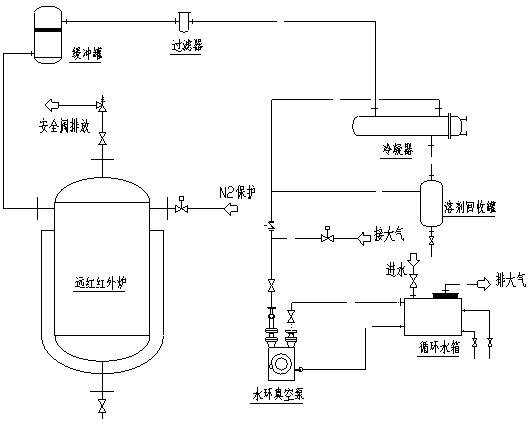Device and method for recovering organic solvent in flammable and explosive high-viscosity polymer waste
A high-viscosity polymer, flammable and explosive technology, applied in the field of organic solvents, can solve the problems of inability to recover solvents, flash explosions, environmental pollution, etc., and achieve the effects of improving air pollution, reducing pollution, and reducing production costs
- Summary
- Abstract
- Description
- Claims
- Application Information
AI Technical Summary
Problems solved by technology
Method used
Image
Examples
Embodiment 1
[0019] Example 1: The production of high-performance fibers requires replacement of components and melt filters every 7 days. There is about 0.25 kg of melt in each component and about 15 kg of melt in each filter. This embodiment is a device for recovering organic solvents in flammable and explosive high-viscosity polymer waste, which can process 50 components and 2 filters each time. The system can process about 42.5 kg of melt in total and recover 80% of the solvent.
[0020] Such as figure 1 As shown, it includes far-infrared furnace, buffer tank, filter, condenser, solvent recovery tank, booster pump, and circulating water tank. Among them, far-infrared furnace, buffer tank, filter, and condenser are connected in sequence, and the condenser is connected to solvent recovery. The tank is connected to the water tank through a vacuum pump, and the side of the water tank has an overflow port. In this embodiment, the vacuum pump is a water ring vacuum pump, which is connected ...
Embodiment 2
[0028] Embodiment 2: roughly the same as Embodiment 1, the difference is that the outer surface of the silicon carbide plate is provided with a refractory brick insulation material with a thickness of 100mm. When the vacuum degree of the system reaches an absolute pressure of 8KPa, the far-infrared furnace starts to heat, and the heating The temperature is set to about 160°C, and the heating time is 10h.
Embodiment 3
[0029] Embodiment 3: roughly the same as Embodiment 1, the difference is that the outer surface of the silicon carbide plate is provided with a rock wool insulation material with a thickness of 400mm. When the vacuum degree of the system reaches an absolute pressure of 15KPa, the far-infrared furnace starts to heat, and the heating The temperature is set to about 180°C, and the heating time is 0.5h.
PUM
| Property | Measurement | Unit |
|---|---|---|
| thickness | aaaaa | aaaaa |
| thickness | aaaaa | aaaaa |
| thickness | aaaaa | aaaaa |
Abstract
Description
Claims
Application Information
 Login to View More
Login to View More - R&D
- Intellectual Property
- Life Sciences
- Materials
- Tech Scout
- Unparalleled Data Quality
- Higher Quality Content
- 60% Fewer Hallucinations
Browse by: Latest US Patents, China's latest patents, Technical Efficacy Thesaurus, Application Domain, Technology Topic, Popular Technical Reports.
© 2025 PatSnap. All rights reserved.Legal|Privacy policy|Modern Slavery Act Transparency Statement|Sitemap|About US| Contact US: help@patsnap.com

